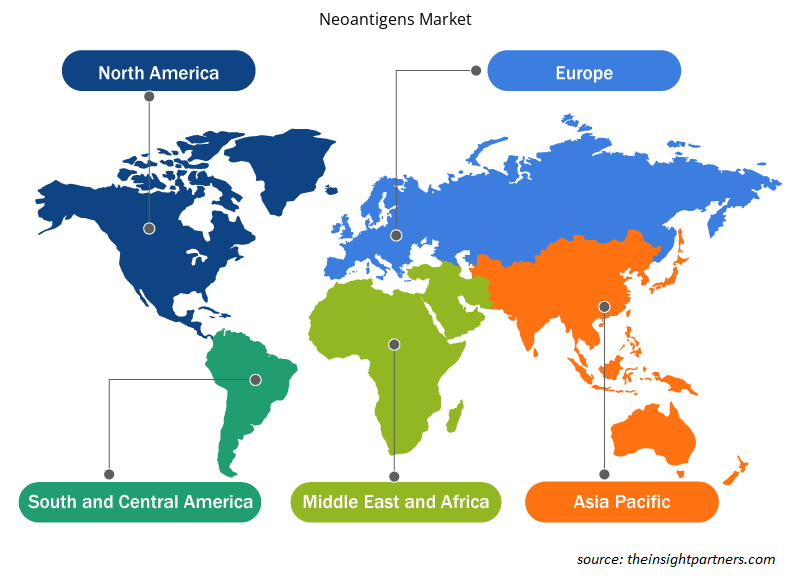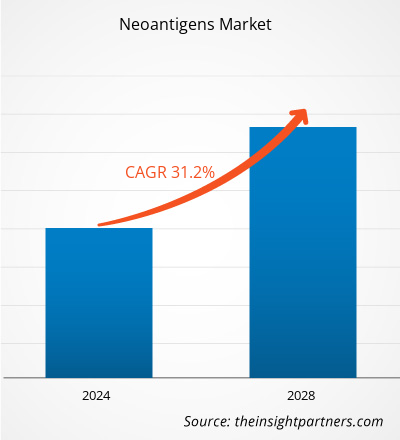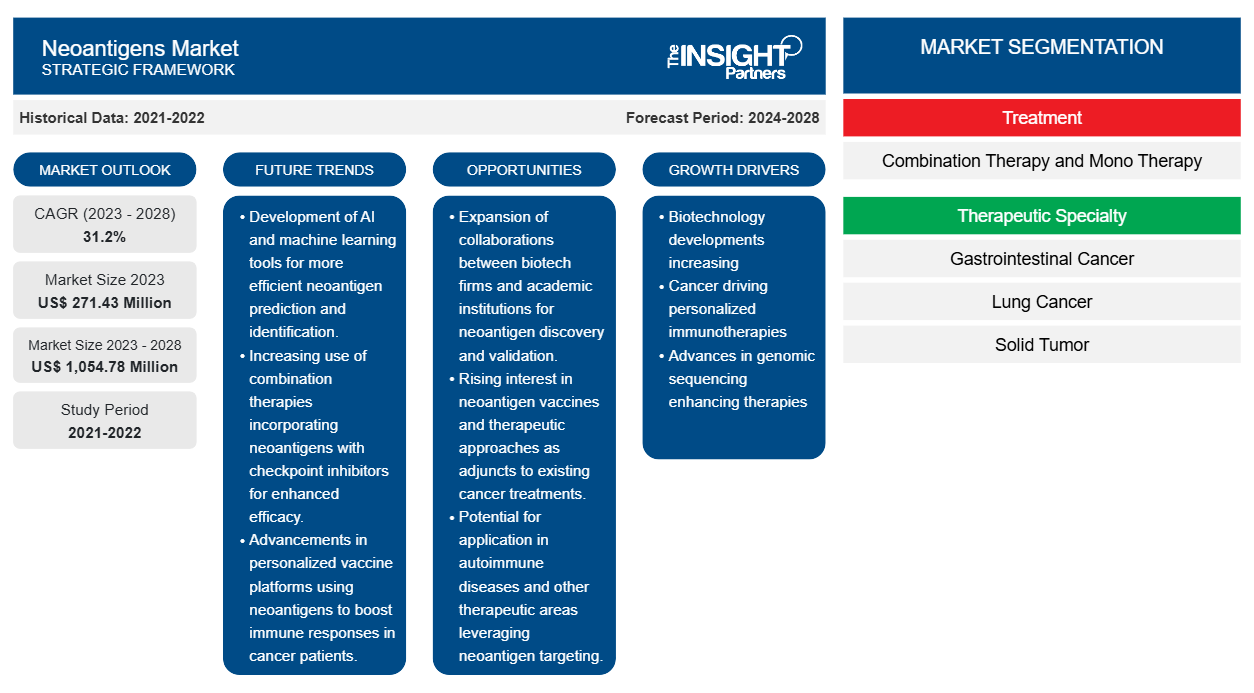Der Markt für Neoantigene wurde im Jahr 2023 auf 271.428,57 US-Dollar geschätzt und soll bis 2028 10.547.8354 US-Dollar erreichen; von 2023 bis 2028 wird ein durchschnittliches jährliches Wachstum von 31,2 % erwartet.
Neoantigene sind neu entwickelte Antigene, die bisher vom Immunsystem nicht erkannt wurden. Veränderungen in Tumorproteinen können zur Entwicklung von Neoantigenen führen, die durch Mutationen oder virale Proteine verursacht werden. Neoantigene werden bei selektiven Behandlungen von Krebszellen eingesetzt.
Der Neoantigenmarkt ist nach Behandlung, therapeutischer Spezialität und Geografie segmentiert. Basierend auf der Geografie ist der Markt in Nordamerika, Europa, Asien-Pazifik, Naher Osten und Afrika sowie Süd- und Mittelamerika segmentiert. Der Bericht bietet Einblicke und eine eingehende Analyse des Neoantigenmarktes und betont dabei verschiedene Parameter wie Markttrends, technologische Fortschritte, Marktdynamik und Wettbewerbslandschaftsanalyse führender Marktteilnehmer auf der ganzen Welt. Es enthält auch eine COVID-19-Auswirkungsanalyse in allen Regionen. Es wird geschätzt, dass der Markt im Prognosezeitraum wahrscheinlich eine stetige Wachstumsrate aufweisen wird.
Passen Sie diesen Bericht Ihren Anforderungen an
Sie erhalten kostenlose Anpassungen an jedem Bericht, einschließlich Teilen dieses Berichts oder einer Analyse auf Länderebene, eines Excel-Datenpakets sowie tolle Angebote und Rabatte für Start-ups und Universitäten.
-
Holen Sie sich die wichtigsten Markttrends aus diesem Bericht.Dieses KOSTENLOSE Beispiel umfasst eine Datenanalyse von Markttrends bis hin zu Schätzungen und Prognosen.
Markteinblicke
Entwicklungen bei Neoantigen-Impfstoffen gegen Krebs
Entwicklungen in der Biotechnologie haben zu einer steigenden Akzeptanz der Immuntherapie geführt und ihren Einsatz in der personalisierten Medizin weiter vorangetrieben. Immuntherapie wird häufig zur Behandlung von Krebs eingesetzt; einige der Immuntherapieverfahren beinhalten die Verwendung von Neoantigenen, den Antigenen, die auf der Oberfläche von Krebszellen vorhanden sind. Daher werden Anwendungen von Neoantigenen zur Behandlung von Krebs umfassend untersucht. Die Einzigartigkeit von Neoantigenen ermöglicht es Forschern, das Immunsystem von Patienten zu identifizieren und Antigene zu finden, um Krebszellen anzugreifen, ohne gesunde Zellen zu stören. Die Entwicklungen in der Immuntherapie nahmen nach 2015 Fahrt auf, als die erste klinische Studie mit Neoantigen-Impfstoffen durchgeführt wurde. 2017 wurden von Neon Therapeutics zwei weitere klinische Studien veröffentlicht, die die Wirksamkeit von Neoantigen-Impfstoffen zur Behandlung von Melanomen (Hautkrebs) beim Menschen bewiesen. Die positiven Ergebnisse der klinischen Studien haben verschiedene Startups dazu veranlasst, neoantigenbasierte Krebstherapeutika zu entdecken und zu entwickeln. Viele Unternehmen haben Interesse an der Entwicklung von Neoantigenen gezeigt. Im Folgenden finden Sie einige Beispiele für Unternehmen, die an der Entwicklung von Neoantigenen beteiligt sind.immunotherapy, further driving its use in personalized medicines. Immunotherapy is widely used to treat cancer; a few the immunotherapy procedures involve the use of neoantigens, the antigens present on the surface of cancer cells. Therefore, applications of neoantigens are being widely studied to treat cancer. The uniqueness of neoantigens allows researchers to identify patients’ immune system and find antigens to target cancer cells without disturbing healthy cells.
immunotherapy caught pace after 2015, when the first clinical trial of neoantigen vaccine was performed. In 2017, two additional clinical trial studies were published by Neon Therapeutics that proved the efficacy of neoantigen vaccine treat melanoma (skin cancer) in humans. The positive results of clinical trials have attracted various startups to discover and develop neoantigen-based cancer therapeutics. Many companies have shown interest in the development of neoantigens. Following are few examples of companies involved in the development of neoantigens.
- BioNTech SE ist ein deutsches Unternehmen, das auf dem Markt für Neoantigenimpfstoffe tätig ist. BioNTech SE hat die Mutanome-Plattform Individualized Vaccines Against Cancer (IVAC) entwickelt, die RNA-Moleküle zur Herstellung maßgeschneiderter Neoantigenimpfstoffe entwickelt. Die klinischen Studien für IVAC, die auf dreifach negativen Brustkrebs, mehrere Tumorarten und Melanome abzielen, stehen noch aus. SE is a German company operating in the neoantigen vaccines market. BioNTech SE has developed Individualized Vaccines Against Cancer (IVAC) Mutanome platform that engineer RNA molecules to produce customized neoantigen vaccine. The clinical trials for IVAC that target triple negative breast cancer, multiple tumor types, and melanoma are pending.
- Die ATLAS-Plattform von Genocea Biosciences verwendet eine Ex-vivo-Methode zur Entwicklung von Neoantigen-Impfstoffen. Genocea Biosciences hat von Investoren wie Polaris Partners, GlaxoSmithKline und Johnson & Johnson Innovation rund 91 Millionen US-Dollar eingesammelt, um seinen Neoantigen-Krebsimpfstoff GEN-009 zu entwickeln. Der Impfstoff befindet sich derzeit in der klinischen Phase 1a/2 und ist für die Behandlung von Melanomen, Lungenkrebs und Karzinomen konzipiert.Genocea Biosciences uses an ex-vivo method to develop neoantigen vaccines. Genocea Biosciences has raised ~US$ 91 million funds from investors such as Polaris Partners, GlaxoSmithKline, and Johnson & Johnson Innovation to develop its neoantigen cancer vaccine—GEN-009. Currently in the Phase 1a/2 clinical trial, the vaccine is designed to treat melanoma, lung cancer, and carcinomas.
- Gritstone Oncology verwendet seine KI-Plattform EDGE, um Neoantigen-Impfstoffe mit einem In-silico-Ansatz zu entwickeln. Das Unternehmen hat zwei Produkte entwickelt: GRANITE-001 und SLATE-001. GRANITE-001 ist als individuelle Behandlung basierend auf dem spezifischen Tumortyp des Patienten konzipiert, während SLATE-001 als allgemeiner Neoantigen-Impfstoff formuliert ist, der für mehrere Patienten mit ähnlichem Neoantigen verwendet werden kann. Oncology uses its AI platform—EDGE—to develop neoantigen vaccines using an in-silico approach. The company has developed two products GRANITE-001 and SLATE-001. GRANITE-001 is designed as an individual treatment based on patient’s specific tumor type, whereas SLATE-001 is formulated as a common neoantigen vaccine that can be used for multiple patients showing similar neoantigen.
- Agenus Inc. hat den Neoantigenimpfstoff AutoSynVax (ASV) entwickelt, der mit dem Adjuvans QS-21 Stimulon zur Behandlung solider Tumore verabreicht wird. ASV befindet sich derzeit in der Phase 1 der klinischen Erprobung in den USA. Inc. has developed AutoSynVax (ASV) neoantigen vaccine that is administered with an adjuvant QS-21 Stimulon to treat solid tumors. At present ASV is in the Phase 1 clinical trial in USA.
- Seit 2016 ist Moderna, Inc. an klinischen Studien für seinen personalisierten Krebsimpfstoff (PCV) mRNA-4157 in Kombination mit Keytruda von Merck beteiligt. Im November 2020 veröffentlichte Moderna, Inc. Updates zu seinen Krebsimpfstoffen, in denen es heißt, dass die Verabreichung von mRNA-4157 in Kombination mit Keytruda in allen Dosierungen gut verträglich ist und bei Patienten Reaktionen hervorgerufen hat.Moderna, Inc. is involved in clinical trials for its personalized cancer vaccine (PCV) mRNA-4157 in combination with Keytruda by Merck. In November 2020, Moderna, Inc. published updates about its cancer vaccines stating that administrating mRNA-4157 in combination with Keytruda is well tolerated at all dose levels and has produced responses in patients.
Solche Entwicklungen bei Neoantigen-Impfstoffen gegen Krebs treiben das Marktwachstum an.neoantigen vaccines against cancer are fuelling the market growth.
Behandlungsbasierte Erkenntnisse
Basierend auf der Behandlung ist der Neoantigenmarkt in Kombinationstherapie und Monotherapie segmentiert. Im Jahr 2023 wird das Segment der Kombinationstherapie voraussichtlich einen größeren Marktanteil haben. Es wird jedoch erwartet, dass das Segment der Monotherapie im Prognosezeitraum schneller wächst.neoantigens market is segmented into combination therapy and mono therapy. In 2023, the combination therapy segment is estimated to have a larger share of the market. However, the mono therapy segment is expected to have a faster growth during the forecast period.
Therapeutische Facheinblicke
Basierend auf der therapeutischen Spezialisierung ist der Markt für Neoantigene in Magen-Darm-Krebs, Lungenkrebs, solide Tumore, Krebserkrankungen der Harnwege, Melanome, Kopf- und Halskrebs und andere unterteilt. Im Jahr 2023 wird das Segment Magen-Darm-Krebs voraussichtlich den größten Marktanteil haben und in den kommenden Jahren voraussichtlich am schnellsten wachsen.
Anorganische Strategien wurden von den Marktteilnehmern in großem Umfang übernommen, um der sich ändernden Kundennachfrage gerecht zu werden und ihre verbesserten Dienstleistungen aufrechtzuerhalten. So kündigt Genocea im Januar 2021 die Veröffentlichung einer Krebsentdeckung an, die auf den Vorteilen der Neoantigenidentifizierung mithilfe der ATLAS-Plattform beruht. Diese Entdeckung stärkt Neoantigen-Immuntherapien, indem sie theoretisch sicherstellt, dass sie auf die richtigen Neoantigene abzielen und gleichzeitig Inhibigene entfernen.
Regionale Einblicke in den Neoantigenmarkt
Die regionalen Trends und Faktoren, die den Neoantigenmarkt während des Prognosezeitraums beeinflussen, wurden von den Analysten von Insight Partners ausführlich erläutert. In diesem Abschnitt werden auch Neoantigenmarktsegmente und die Geografie in Nordamerika, Europa, im asiatisch-pazifischen Raum, im Nahen Osten und Afrika sowie in Süd- und Mittelamerika erörtert.

- Holen Sie sich die regionalspezifischen Daten für den Neoantigenmarkt
Umfang des Neoantigene-Marktberichts
| Berichtsattribut | Details |
|---|---|
| Marktgröße im Jahr 2023 | 271,43 Millionen US-Dollar |
| Marktgröße bis 2028 | 1.054,78 Millionen US-Dollar |
| Globale CAGR (2023 - 2028) | 31,2 % |
| Historische Daten | 2021-2022 |
| Prognosezeitraum | 2024–2028 |
| Abgedeckte Segmente |
Nach Behandlung
|
| Abgedeckte Regionen und Länder |
Nordamerika
|
| Marktführer und wichtige Unternehmensprofile |
|
Dichte der Marktteilnehmer für Neoantigene: Deren Auswirkungen auf die Geschäftsdynamik
Der Markt für Neoantigene wächst rasant, angetrieben durch die steigende Nachfrage der Endnutzer aufgrund von Faktoren wie sich entwickelnden Verbraucherpräferenzen, technologischen Fortschritten und einem größeren Bewusstsein für die Vorteile des Produkts. Mit steigender Nachfrage erweitern Unternehmen ihr Angebot, entwickeln Innovationen, um die Bedürfnisse der Verbraucher zu erfüllen, und nutzen neue Trends, was das Marktwachstum weiter ankurbelt.
Die Marktteilnehmerdichte bezieht sich auf die Verteilung der Firmen oder Unternehmen, die in einem bestimmten Markt oder einer bestimmten Branche tätig sind. Sie gibt an, wie viele Wettbewerber (Marktteilnehmer) in einem bestimmten Marktraum im Verhältnis zu seiner Größe oder seinem gesamten Marktwert präsent sind.
Die wichtigsten auf dem Neoantigen-Markt tätigen Unternehmen sind:
- Achilles Therapeutics plc
- Advaxis, Inc.
- Rahmenkrebstherapeutika
- Genua
- Gradalis, Inc.
Haftungsausschluss : Die oben aufgeführten Unternehmen sind nicht in einer bestimmten Reihenfolge aufgeführt.

- Überblick über die wichtigsten Akteure auf dem Neoantigenmarkt
Nach Behandlung
- Kombinationstherapie
- Monotherapie
Nach therapeutischer Spezialität
- Magen-Darm-Krebs
- Lungenkrebs
- Solide Tumoren
- Krebserkrankungen des Harnsystems
- Melanom
- Kopf- und Halskrebs
- Sonstiges
Nach Geografie
-
Nordamerika
- UNS
- Kanada
- Mexiko
-
Europa
- Frankreich
- Deutschland
- Italien
- Vereinigtes Königreich
- Spanien
- Restliches Europa
-
Asien-Pazifik (APAC)
- China
- Indien
- Südkorea
- Japan
- Australien
- Restlicher Asien-Pazifik-Raum
-
Naher Osten und Afrika (MEA)
- Südafrika
- Saudi-Arabien
- Vereinigte Arabische Emirate
- Rest von MEA
-
Süd- und Mittelamerika (SCAM)
- Brasilien
- Argentinien
- Rest von SCAM
Firmenprofile
- Achilles Therapeutics plc
- Advaxis, Inc.
- Rahmenkrebstherapeutika
- Genocea, Gradalis, Inc.
- Gritstone Onkologie
- Immunicum AB
- Medigene AG
- Ziopharm Oncology, Inc.
- Moderna, Inc.
- Historische Analyse (2 Jahre), Basisjahr, Prognose (7 Jahre) mit CAGR
- PEST- und SWOT-Analyse
- Marktgröße Wert/Volumen – Global, Regional, Land
- Branchen- und Wettbewerbslandschaft
- Excel-Datensatz
Aktuelle Berichte
Erfahrungsberichte
Grund zum Kauf
- Fundierte Entscheidungsfindung
- Marktdynamik verstehen
- Wettbewerbsanalyse
- Kundeneinblicke
- Marktprognosen
- Risikominimierung
- Strategische Planung
- Investitionsbegründung
- Identifizierung neuer Märkte
- Verbesserung von Marketingstrategien
- Steigerung der Betriebseffizienz
- Anpassung an regulatorische Trends























 Kostenlose Probe anfordern für - Neoantigen-Markt
Kostenlose Probe anfordern für - Neoantigen-Markt